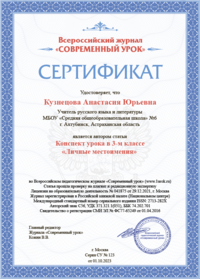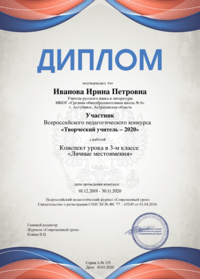Визуализация учебного материала в процессе обучения английскому языку в начальной школе
Автор: Похвальная Татьяна Вячеславовна
Организация: МОБУ СОШ №8 им. А.Г. Ломакина
Населенный пункт: Ростовская область, г.Таганрог
Аннотация. В статье анализируются такие современные способы визуализации учебного материала на уроках английского языка в школе как ментальная карта, скрайбинг, инфографика, лэпбук и интерактивная тетрадь. Автор делает вывод о том, что используемая в обучении английскому языку система средств визуализации предусматривает в качестве цели реализацию учебного, воспитательного, развивающего и познавательного потенциалов иноязычного образования.
Ключевые слова: визуализация, ментальная карта, скрайбинг, инфографика, лэпбук, интерактивная тетрадь
Visualization of Learning Material in Teaching English at Primary School
Pokhvalnaya Tatyana Vyacheslavovna
Abstract. The article analyzes such modern means of visualizing educational material in English classes at school as a mental map, scribing, infographics, a laptop and an interactive notebook. The author concludes that the visualization system used in teaching English provides for the educational, educational, developmental and cognitive potentials of teaching a foreign language.
Keywords: visualization, mental map, scribing, infographics, laptop, interactive notebook.
The use of visualization is characteristic of all stages of schooling and the scope of its application is constantly expanding. In modern learning conditions we are increasingly talking not just about visual aids but about visualization. The concept of “visualization” must be distinguished from traditional visual aids since visualization is the process of folding content into a visual image that can be deployed on the basis of mental activities. Despite the significant distribution of visual aids, their use in the learning process is often unsystematic and chaotic. In this regard, it is necessary to use a systematic approach to develop complexes of visual aids in teaching English.
According to A.N. Schukin, the totality of certain elements of the educational process is combined into a system provided that a single goal is achieved (in this case, the goal of language acquisition). The elements are closely interconnected and are manifested in each specific act of educational activity; they are formed under the influence of the environment that dictates the requirements concerning what and how to train students in connection with the needs of society; they are combined with each other through the learning goal as a system-forming component of the system [4, p. 71].
Thus, the main purpose of creating a visualization system for teaching English should be determined as the basis for its functioning. When defining the visualization system goals in teaching a foreign language, we rely on the concept of foreign language education developed by E.I. Passov, according to whom teaching a foreign language has four aspects: cognitive, developing, cultural and educational [3, p. 8].
That is why, as a target component of the system, we consider the educational, upbringing, developing and cognitive potentials of teaching a foreign language via visualization of information and visualization of knowledge. The effective functioning of the system is also ensured through a set of developed principles, since these principles ensure continuity in the system.
The principle of cognitive visualization follows from psychological patterns, according to which the effectiveness of the assimilation of information and knowledge gets increased if cognitive graphic learning elements (which have not only an illustrative but also a cognitive function) are used in teaching. This leads to the fact that the right hemisphere is connected to the assimilation process. At the same time, the visual supports (drawings, diagrams, models) which compactly illustrate the content, contribute to systematic knowledge.
Visualization techniques can be used at various stages of teaching: when explaining new material, revising and reinforcement. Today there is a wide variety of visualization tools to refer to [2].
An intelligence map (mental map, connection diagram, thought map, associative map) is a graphic way to present ideas, concepts, information in the form of a map consisting of key and secondary topics. In other words, it is a tool for structuring ideas, planning your time, memorizing large amounts of information and conducting brainstorming sessions.
Scribing is visualization of information by using graphic symbols that simply and clearly display its contents and internal connections. The scribing technique was invented by the British artist Andrew Park. This is the art of accompanying the delivered speech with drawings with a felt-tip pen on a white board (or sheet of paper). As a rule, the key moments of the story and the interrelationship between them are illustrated. The creation of vivid images causes the listener to enjoy visual associations with the delivered speech thus providing a high level of information assimilation.
Infographics are a graphic way of presenting information, data and knowledge. The basic principles of infographics are informativeness, meaning, easy perception and allegorism. Tables, charts, graphic elements can be used to create infographics.
The “lapbook” is an interactive folder, a folder full of students’ projects, windows and movable elements. It contains material on a specific topic. The laptop is not only a powerful reference tool and a special form of organizing educational material, it is, above all, the basis of learners’ project activities. The basis of the “laptop” is created by the teacher and supplemented by school students. The result of this work is a well-designed research project.
An interactive notebook is one of the creative and interesting teaching methods, an absolutely fresh look at keeping notebooks at school. This is a notebook that contains various interactive templates and elements aimed mainly at studying the rules and vocabulary on various topics. The information in the interactive notebook is not united by one topic, it has no plot. It is convenient to include all the grammar rules and constructions learned at the lessons. It helps to revitalize the lessons, create conditions for the practical use of theoretical information, keep the studied topics and constructions in one place, and revise the material several times.
The main advantage of using interactive notebooks is that the interactive elements in them help your students to save space in ordinary notebooks, thereby fitting more information; children learn to organize information; this must also be taught so that it would be easier for them to deal with information later in life; grammar theory is visualized and this facilitates the understanding of the material, in addition, motility is also involved (the elements are constantly moving, being pulled out); children show their individuality and imagination, they are involved in the process, their creative abilities are also developed; their interest in notebooks is sustained, motivation for learning English gets increased; interactive notebooks encourage learners’ continuous viewing and repetition.
Summing up, it should be said that the system of visualization tools used in teaching English provides for educational, upbringing, developing and cognitive potentials of foreign language teaching through visualization of information and knowledge, as well as the transfer of accessible, easily digestible lexical, grammatical, phonetic and communicative knowledge.
References
1. Galskova N.D. Modern Methods of Teaching Foreign Languages: A Manual for Teachers. – M.: Publishing House of ARKTI, 2000.
2. Mikhaleva G.V. Productive Educational Technologies in Teaching a Foreign Language at a University // Materials of the Regional Scientific-Practical Conference “Actual Problems of Philology and Methods of Teaching Foreign Languages – Rostov-on-Don – Taganrog: RSEU (RINH), 2019. – P. 172-173.
3. Passov E.I. A Foreign Language Lesson / E.I. Passov, N.E. Kuzovleva – Rostov-on-Don: Publishing House “Phoenix, GLOSSA-Press”, 2010.
4. Schukin A.N. Teaching Foreign Languages: Theory and Practice. – M., 2006.






